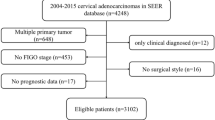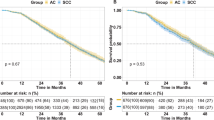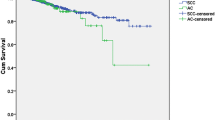Abstract
Objective
Double primary cervical cancer and ovarian cancer refer to the simultaneous or successive appearance of cervical cancer and ovarian cancer in the same patient. Due to the low incidence, there are few relevant reports. Therefore, this study is the first population-based analysis of the clinicopathological features as well as the prognostic status of double primary cervical cancer and ovarian cancer. We look forward to providing a reference for future clinical diagnosis and treatment.
Methods
In this study, 473 cases of double primary cervical cancer and ovarian cancer were collected from 1975 to 2019 through the SEER database. Double primary cancers were considered non-synchronous when they were diagnosed more than 6 months apart and were classified as Group A. Double primary cancers were considered synchronous when the interval between diagnosis of the two tumors was less than or equal to 6 months and was classified as group B.
Results
In this study, the incidence of double primary cervical cancer and ovarian cancer accounted for 0.39% of primary cervical cancer and 0.24% of primary ovarian cancer in the same period. 80% of patients developed second cancer within 107 months of their first cancer being diagnosed. Compared with non-synchronous cancer, synchronous cancer is mainly characterized by simultaneous bilateral ovarian involvement and early clinical stage, but highly malignant, high lymph node metastasis rate, and poor prognosis.
Conclusion
Most patients developed second cancer within 107 months of their first cancer being diagnosed. Age at diagnosis, bilateral ovarian invasion, the interval between diagnoses, pathological type and stage of ovarian cancer, and grade of cervical cancer are important factors affecting survival, which still needs to be confirmed by more extensive studies in future.



Similar content being viewed by others
Data availability
The data that support the findings of this study are available from the corresponding author, upon reasonable request.
References
Ayhan A et al (1992) Synchronous primary malignancies of the female genital tract. Eur J Obstet Gynecol Reprod Biol 45(1):63–66
Eisner RF, Nieberg RK, Berek JS (1989) Synchronous primary neoplasms of the female reproductive tract. Gynecol Oncol 33(3):335–339
Fagotti A et al (2012) Systematic pelvic and aortic lymphadenectomy in advanced ovarian cancer patients at the time of interval debulking surgery: a double-institution case-control study. Ann Surg Oncol 19(11):3522–3527
Gilks CB, Kommoss F (2018) Synchronous tumours of the female reproductive tract. Pathology 50(2):214–221
Harter P et al (2019) A randomized trial of lymphadenectomy in patients with advanced ovarian neoplasms. N Engl J Med 380(9):822–832
Hatakeyama K et al (2021) Mutational concordance analysis provides supportive information for double cancer diagnosis. BMC Cancer 21(1):181
He Y et al (2022) Clinical analysis of 23 cases with simultaneous double primary gynecological malignant tumors. Zhonghua Fu Chan Ke Za Zhi 57(5):352–360
Ramus SJ et al (2008) Predicting clinical outcome in patients diagnosed with synchronous ovarian and endometrial cancer. Clin Cancer Res 14(18):5840–5848
Schultheis AM et al (2016) Massively parallel sequencing-based clonality analysis of synchronous endometrioid endometrial and ovarian carcinomas. J Natl Cancer Inst 108(6):djv427
Schwartz L et al (2015) Impact of pelvic and para-aortic lymphadenectomy in advanced ovarian cancer after neoadjuvant chemotherapy. Anticancer Res 35(10):5503–5509
Singh N (2010) Synchronous tumours of the female genital tract. Histopathology 56(3):277–285
Soliman PT et al (2004) Synchronous primary cancers of the endometrium and ovary: a single institution review of 84 cases. Gynecol Oncol 94(2):456–462
Sung H et al (2021) Global Cancer Statistics 2020: GLOBOCAN estimates of incidence and mortality worldwide for 36 cancers in 185 Countries. CA Cancer J Clin 71(3):209–249
Tong SY et al (2008) Clinical analysis of synchronous primary neoplasms of the female reproductive tract. Eur J Obstet Gynecol Reprod Biol 136(1):78–82
Woodruff JD, Julian CG (1969) Multiple malignancy in the upper genital canal. Am J Obstet Gynecol 103(6):810–822
Wu RC et al (2017) Elucidating the pathogenesis of synchronous and metachronous tumors in a woman with endometrioid carcinomas using a whole-exome sequencing approach. Cold Spring Harb Mol Case Stud 3(6):a001693
Young RH, Scully RE (1988) Mucinous ovarian tumors associated with mucinous adenocarcinomas of the cervix clinicopathological analysis of 16 cases. Int J Gynecol Pathol 7(2):99–111
Zaino R et al (2001) Simultaneously detected endometrial and ovarian carcinomas–a prospective clinicopathologic study of 74 cases: a gynecologic oncology group study. Gynecol Oncol 83(2):355–362
Funding
Non-financial support for the article.
Author information
Authors and Affiliations
Contributions
YH was involved in protocol development, data analysis, manuscript writing and editing. XW contributed to data collection. XL, JC were involved in data analysis. LO contributed to data analysis and manuscript editing. YL was involved in protocol development, literature screening, and manuscript editing.
Corresponding author
Ethics declarations
Competing interests
The authors declare no competing interests.
Conflict of interest
All the authors declare that they have no conflict of interest.
Ethical approval
Not applicable.
Declarations.
Consent to publish
The authors affirm that human research participants provided informed consent for publication of the images in Figs. 1, 2 and 3.
Additional information
Publisher's Note
Springer Nature remains neutral with regard to jurisdictional claims in published maps and institutional affiliations.
Supplementary Information
Below is the link to the electronic supplementary material.
Rights and permissions
Springer Nature or its licensor (e.g. a society or other partner) holds exclusive rights to this article under a publishing agreement with the author(s) or other rightsholder(s); author self-archiving of the accepted manuscript version of this article is solely governed by the terms of such publishing agreement and applicable law.
About this article
Cite this article
Han, Y., Wang, X., Li, X. et al. Analysis of clinicopathological features and prognosis of double primary cervical cancer and ovarian cancer based on SEER database. J Cancer Res Clin Oncol 149, 16407–16415 (2023). https://doi.org/10.1007/s00432-023-05373-y
Received:
Accepted:
Published:
Issue Date:
DOI: https://doi.org/10.1007/s00432-023-05373-y




